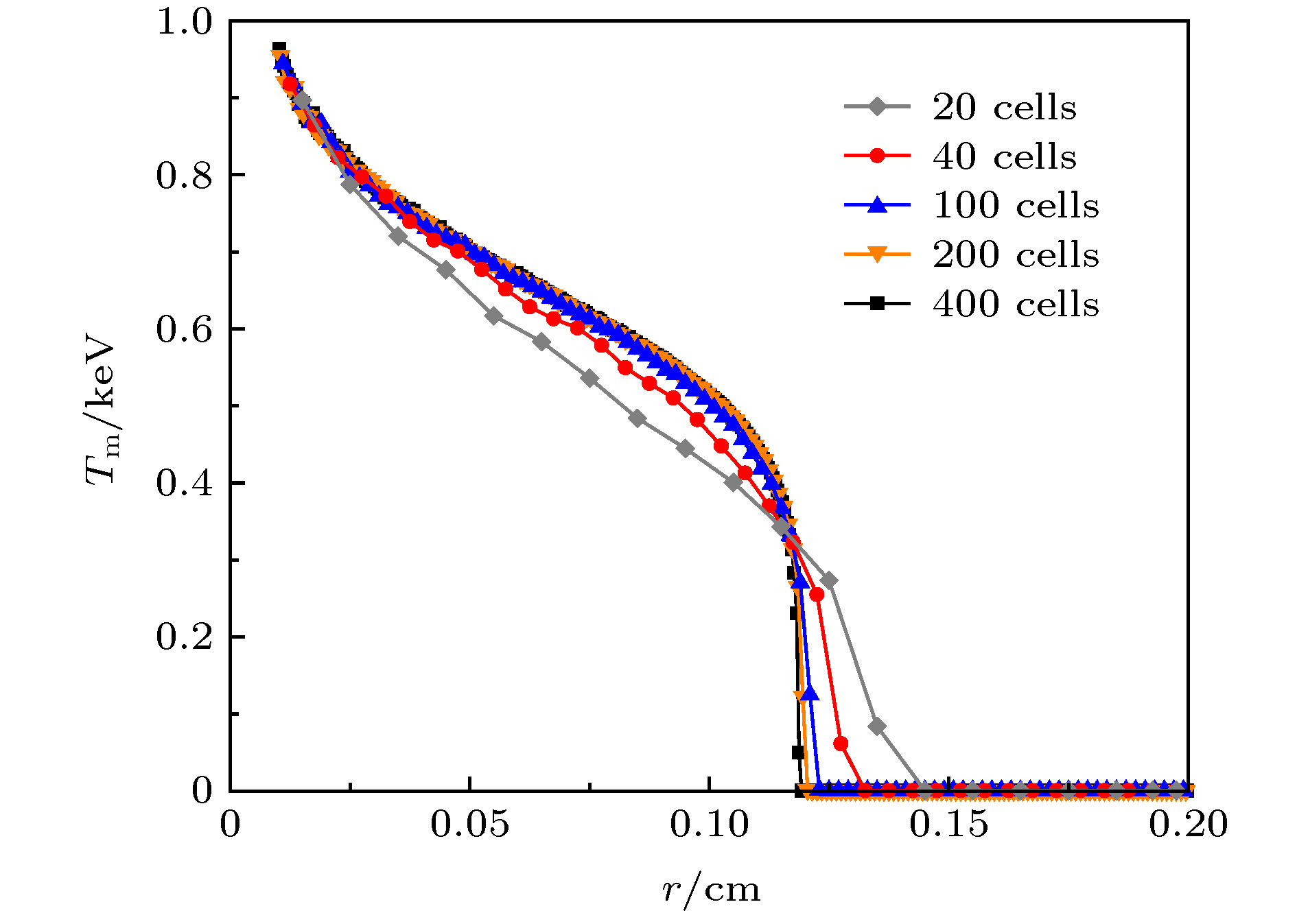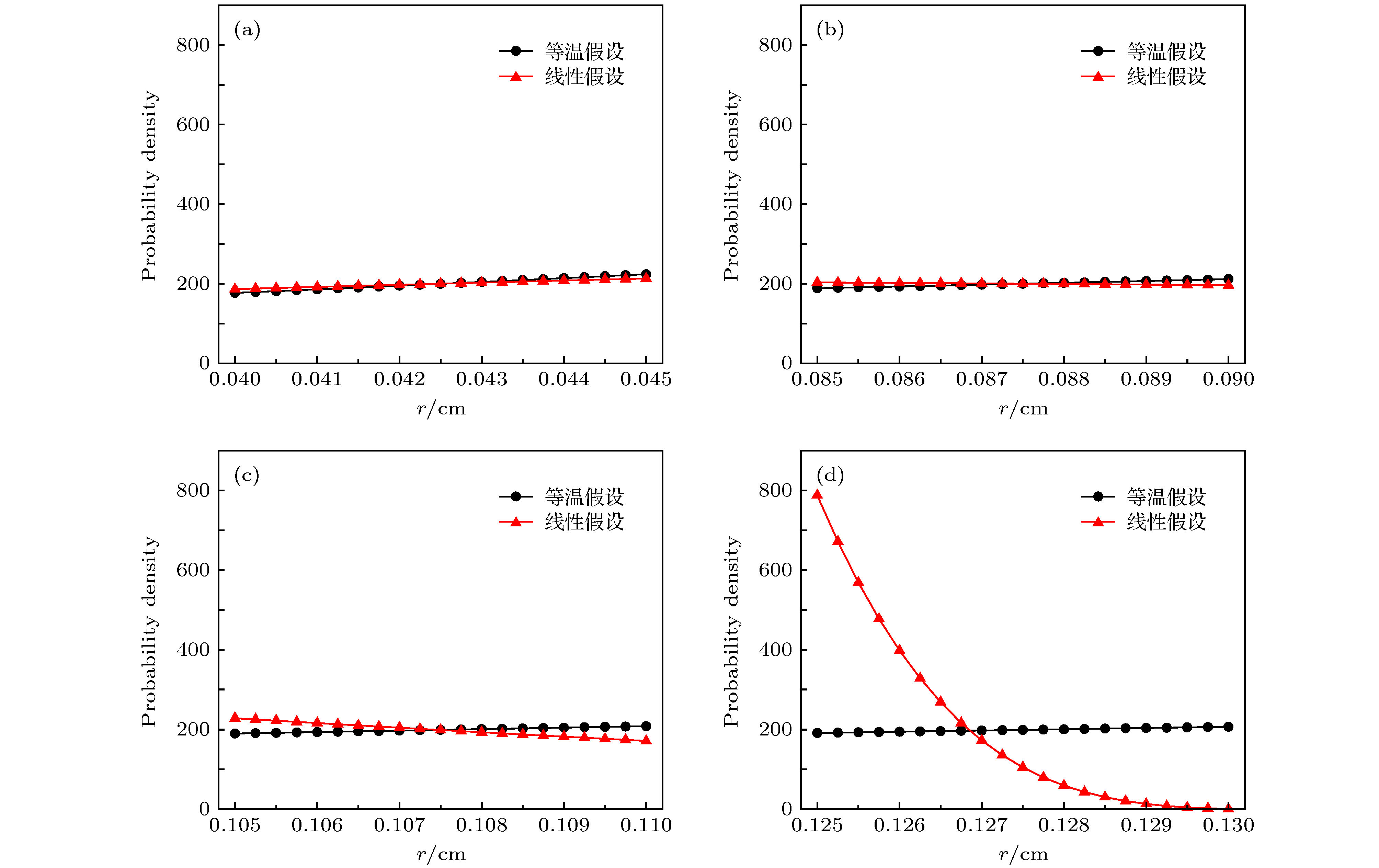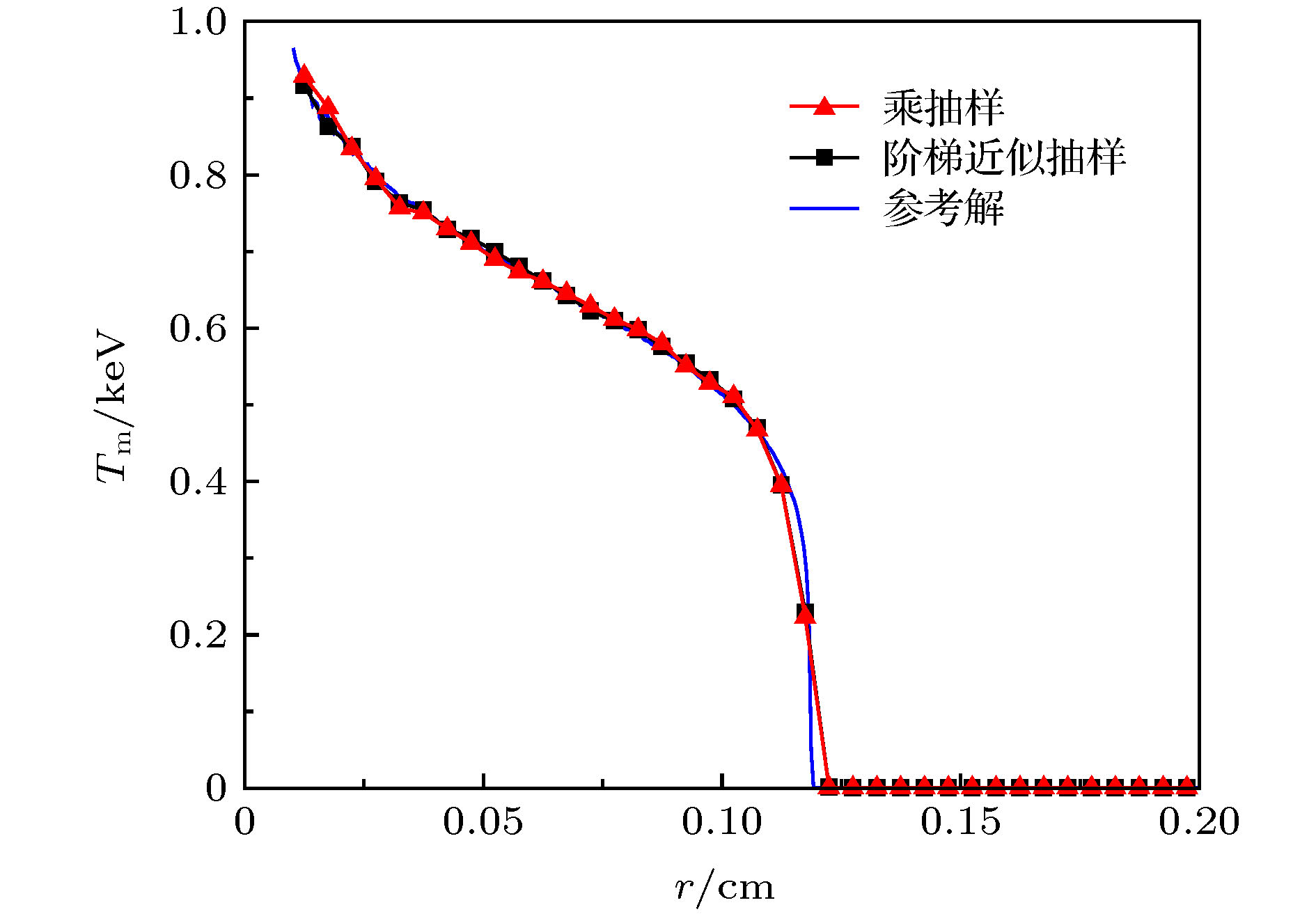-
利用隐式蒙特卡罗方法模拟热辐射输运问题时, 辐射源粒子的抽样对结果的正确性很重要. 在球几何热辐射输运隐式蒙特卡罗模拟中, 通常的做法是假设单个网格(球壳)的温度不随空间变化, 即源粒子在球壳内均匀分布. 对于网格内部温度分布梯度不大的情况, 这种处理不会造成太大误差, 然而当物质的吸收系数很大或球壳较厚时, 那么单个网格内温度的空间变化也可能较大, 这种处理将导致模拟的热辐射传播速度比实际的要快. 本文分析了导致这种偏差的原因, 并基于辐射能量密度分布, 推导了球几何下辐射源粒子发射位置的概率密度函数, 提出了两种辐射源粒子空间抽样方法, 设计了抽样流程, 计算了典型的热辐射输运问题. 数值计算表明, 这两种新的源粒子空间抽样方法均能修正辐射传播速度与参考值的偏差, 解决计算结果过分依赖于网格剖分的问题. 同时, 在网格数较少、模拟粒子数较少的情况下新方法仍能得到较准确的结果, 有效提高了计算效率.Sampling of radiation source particles is important for obtaining a correct result in the thermal radiative transfer simulation with implicit Monte Carlo. When conducting the implicit Monte Carlo simulation of spherical geometry, temperature in a cell (a spherical shell) is generally treated as a spatially independent value. That means that the particles of radiative source are uniformly distributed in a spherical shell. In some cases where the gradient of temperature inside a cell is relatively small, the treatment does not cause too many errors. However, when the opacity of material becomes large enough or the spherical shell becomes thick enough, the temperature of thermal wave head will change sharply and there will be a great temperature gradient even in a single spherical shell. The treatment will make the thermal radiation propagate much faster than the practical one, which is unacceptable in physics. We investigate the physical and numerical reasons for this violation, finding that the simulation results strongly rely on the separation of cell and that the thermal wave propagates faster with the cell number decreasing. In order to yield an accurate result, the cell number has to increase up to a large enough value. Unfortunately, more cells need more particles to reduce the numerical variance, and more particles will cost more computation time and thus causing the simulation efficiency to lower. In our work, temperature is not treated as a constant in space any more. Instead, it is treated as a linear function in a cell. Based on a new temperature function and radiative energy density distribution, a probability density distribution function of emitting position of radiation source particle in spherical geometry is obtained. Then two new spatial sampling methods are proposed and the sampling procedures of radiation source particle are designed. To verify our new sampling methods, we test several typical thermal radiative problems and compare the result with a reference solution. Numerical experiments show that both two new sampling methods can correct the errors of thermal radiative propagation speed and overcome the difficulty that simulation result is strongly dependent on cell number. In addition, both new sampling methods can obtain an accurate result even with less cells and less particles, which can saves plenty of computation time and improves the simulation efficiency.
-
Keywords:
- implicit Monte Carlo /
- thermal radiation transport /
- spherical geometry /
- spatial sampling
[1] 彭惠民 2008 等离子体中辐射输运和辐射流体力学 (北京: 国防工业出版社) 第38页
Peng H M 2008 Radiation Transport and Radiation Hydrodynamics in Plasmas (Beijing: National Defense Industry Press) p38 (in Chinese)
[2] Hammersly J M, Handscomb D C 1964 Monte Carlo Method (New York: John Wiley & Sons Press) p76
[3] 裴鹿成, 张孝泽 1980 蒙特卡罗方法及其在粒子输运问题中的应用 (北京: 科学出版社) 第18页
Pei L C, Zhang X Z 1980 Monte Carlo Method and Application in Particle Transportation (Beijing: Science Press) p18 (in Chinese)
[4] Fleck J A 1963 Computational Method in the Physical Sciences (Vol. 1) (New York: McGraw-Hill) p43
[5] Campbell P M, Nelson R G 1964 Livermore, Calif : Lawrence Radiation Laboratory Report UCRL-7838
[6] Fleck J A, Cummings J D 1971 J. Comput. Phys. 8 313
 Google Scholar
Google Scholar
[7] Evans T M, Urbatsch T J 2002 MILAGRO : A Parallel Implicit Monte Carlo Code for 3-D Radiative Transfer (Los Alamos: Los Alamos National Laboratory) pNM 87545
[8] Kasen D, Thomas R C, Nugent P 2006 Astrophys. J. 651 366
 Google Scholar
Google Scholar
[9] Kromer M, Sim S A 2009 Mon. Not. R. Astron. Soc. 398 1809
 Google Scholar
Google Scholar
[10] Wollaeger R T, van Rossum D R, Graziani C, Couch S M, Jordan G C, Lamb D Q, Moses G A 2013 Astrophys. J. Suppl. Ser. 209 20
 Google Scholar
Google Scholar
[11] Fleck J A, J R, Canfield E H 1984 J. Comput. Phys. 54 508
 Google Scholar
Google Scholar
[12] Giorla J, Sentis R 1987 J. Comput. Phys. 70 145
 Google Scholar
Google Scholar
[13] Gentile N A 2001 J. Comput. Phys. 172 543
 Google Scholar
Google Scholar
[14] Densmore J D, Urbatsch T J, Evans T M, Buksas M W 2007 J. Comput. Phys. 222 485
 Google Scholar
Google Scholar
[15] Densmore J D, Thompson K G, Urbatsch T J 2012 J. Comput. Phys. 231 6924
 Google Scholar
Google Scholar
[16] 李树, 李刚, 田东风, 邓力 2013 62 249501
 Google Scholar
Google Scholar
Li S, Li G, Tian D F, Deng L 2013 Acta Phys. Sin. 62 249501
 Google Scholar
Google Scholar
[17] Huo W Y, Li Z C, Yang D, Lan K, Liu J, Ren G L, Li S W, Yang Z W, Guo L, Hou L F, Xie X F, Li Y K, Deng K L, Yuan Z, Zhan X Y, Yuan G H, Zhang H J, Jiang B B, Huang L Z, Du K, Zhao R C, Li P, Wang W, Su J Q, Ding Y K, He X T, Zhang W Y 2016 Matter Radiat. Extremes 1 2
 Google Scholar
Google Scholar
[18] 李树, 陈耀华, 姬志成, 章明宇, 任国利, 霍文义, 闫威华, 韩小英, 李志超, 刘杰, 蓝可 2018 67 025202
 Google Scholar
Google Scholar
Li S, Chen Y H, Ji Z C, Zhang M Y, Ren G L, Huo W Y, Yan W H, Han X Y, Li Z C, Liu J, Lan K 2018 Acta Phys. Sin. 67 025202
 Google Scholar
Google Scholar
[19] Feng T G, Lai D X 1996 Sci. China: E 39 461
 Google Scholar
Google Scholar
[20] 李树, 邓力, 田东风, 李刚 2014 63 239501
 Google Scholar
Google Scholar
Li S, Deng L, Tian D F, Li G 2014 Acta Phys. Sin. 63 239501
 Google Scholar
Google Scholar
[21] Wollaber A B 2008 Ph.D. Dissertation (Ann Arbor: University of Michigan)
[22] 许淑艳 2006 蒙特卡罗方法在实验核物理中的应用 (北京: 原子能出版社) 第46页
Xu S Y 2006 Applications of Monte Carlo Method in Experimental Nuclear Physics (Beijing: Atomic Energy Press) p46 (in Chinese)
-
图 4 辐射波不同位置的辐射源粒子空间分布概率密度 (a)网格9, 波后处; (b)网格18, 波后处; (c)网格22, 波头处; (d)网格26, 波头处
Fig. 4. Spatial probability density distribution of radiation source particle in different positions of radiation wave: (a) Cell 9, in the behind of wave; (b) cell 18, in the behind of wave; (c) cell 22, in the head of wave; (d) cell 26, in the head of wave.
表 1 不同网格数时的温度曲线相对参考解的标准偏差和最大误差
Table 1. Relative to the reference solution, the standard deviation and the maximum error of temperature curves with different cell numbers.
Cell number Standard deviation/eV Maximum error/eV 20 80.8 273 40 48.7 254 100 28.9 245 200 13.0 125 表 2 不同网格数的计算时间
Table 2. Computation time with different cell numbers.
Cell number Particle number Computation time/s 20 1 × 104 1.80 × 103 40 2 × 104 2.72 × 103 100 5 × 104 5.74 × 103 200 2 × 105 2.28 × 104 400 4 × 105 5.06 × 104 表 3 不同网格数时的温度曲线相对基准解的标准偏差和最大误差
Table 3. Relative to the reference solution, the standard deviation, and the maximum error of temperature curves with difference cell numbers.
Cell number 乘抽样法 阶梯近似抽样法 Standard deviation/eV Maximum error/eV Standard deviation/eV Maximum error/eV 20 21.60 91.6 18.80 77.8 40 13.60 75.4 12.40 68.7 100 10.40 77.9 10.40 87.6 200 5.64 63.3 5.27 59.5 表 4 计算问题所花时间
Table 4. Computation time of the problem.
Sampling method Cell number Particle number/104 Computation time/103 s 等温法抽样 20 1 1.80 40 2 2.72 100 5 5.74 200 20 22.80 400 40 50.60 乘抽样法 20 1 1.65 40 2 2.56 100 5 5.64 200 20 22.40 阶梯近似抽样法 20 1 1.61 40 2 2.58 100 5 5.75 200 20 22.40 -
[1] 彭惠民 2008 等离子体中辐射输运和辐射流体力学 (北京: 国防工业出版社) 第38页
Peng H M 2008 Radiation Transport and Radiation Hydrodynamics in Plasmas (Beijing: National Defense Industry Press) p38 (in Chinese)
[2] Hammersly J M, Handscomb D C 1964 Monte Carlo Method (New York: John Wiley & Sons Press) p76
[3] 裴鹿成, 张孝泽 1980 蒙特卡罗方法及其在粒子输运问题中的应用 (北京: 科学出版社) 第18页
Pei L C, Zhang X Z 1980 Monte Carlo Method and Application in Particle Transportation (Beijing: Science Press) p18 (in Chinese)
[4] Fleck J A 1963 Computational Method in the Physical Sciences (Vol. 1) (New York: McGraw-Hill) p43
[5] Campbell P M, Nelson R G 1964 Livermore, Calif : Lawrence Radiation Laboratory Report UCRL-7838
[6] Fleck J A, Cummings J D 1971 J. Comput. Phys. 8 313
 Google Scholar
Google Scholar
[7] Evans T M, Urbatsch T J 2002 MILAGRO : A Parallel Implicit Monte Carlo Code for 3-D Radiative Transfer (Los Alamos: Los Alamos National Laboratory) pNM 87545
[8] Kasen D, Thomas R C, Nugent P 2006 Astrophys. J. 651 366
 Google Scholar
Google Scholar
[9] Kromer M, Sim S A 2009 Mon. Not. R. Astron. Soc. 398 1809
 Google Scholar
Google Scholar
[10] Wollaeger R T, van Rossum D R, Graziani C, Couch S M, Jordan G C, Lamb D Q, Moses G A 2013 Astrophys. J. Suppl. Ser. 209 20
 Google Scholar
Google Scholar
[11] Fleck J A, J R, Canfield E H 1984 J. Comput. Phys. 54 508
 Google Scholar
Google Scholar
[12] Giorla J, Sentis R 1987 J. Comput. Phys. 70 145
 Google Scholar
Google Scholar
[13] Gentile N A 2001 J. Comput. Phys. 172 543
 Google Scholar
Google Scholar
[14] Densmore J D, Urbatsch T J, Evans T M, Buksas M W 2007 J. Comput. Phys. 222 485
 Google Scholar
Google Scholar
[15] Densmore J D, Thompson K G, Urbatsch T J 2012 J. Comput. Phys. 231 6924
 Google Scholar
Google Scholar
[16] 李树, 李刚, 田东风, 邓力 2013 62 249501
 Google Scholar
Google Scholar
Li S, Li G, Tian D F, Deng L 2013 Acta Phys. Sin. 62 249501
 Google Scholar
Google Scholar
[17] Huo W Y, Li Z C, Yang D, Lan K, Liu J, Ren G L, Li S W, Yang Z W, Guo L, Hou L F, Xie X F, Li Y K, Deng K L, Yuan Z, Zhan X Y, Yuan G H, Zhang H J, Jiang B B, Huang L Z, Du K, Zhao R C, Li P, Wang W, Su J Q, Ding Y K, He X T, Zhang W Y 2016 Matter Radiat. Extremes 1 2
 Google Scholar
Google Scholar
[18] 李树, 陈耀华, 姬志成, 章明宇, 任国利, 霍文义, 闫威华, 韩小英, 李志超, 刘杰, 蓝可 2018 67 025202
 Google Scholar
Google Scholar
Li S, Chen Y H, Ji Z C, Zhang M Y, Ren G L, Huo W Y, Yan W H, Han X Y, Li Z C, Liu J, Lan K 2018 Acta Phys. Sin. 67 025202
 Google Scholar
Google Scholar
[19] Feng T G, Lai D X 1996 Sci. China: E 39 461
 Google Scholar
Google Scholar
[20] 李树, 邓力, 田东风, 李刚 2014 63 239501
 Google Scholar
Google Scholar
Li S, Deng L, Tian D F, Li G 2014 Acta Phys. Sin. 63 239501
 Google Scholar
Google Scholar
[21] Wollaber A B 2008 Ph.D. Dissertation (Ann Arbor: University of Michigan)
[22] 许淑艳 2006 蒙特卡罗方法在实验核物理中的应用 (北京: 原子能出版社) 第46页
Xu S Y 2006 Applications of Monte Carlo Method in Experimental Nuclear Physics (Beijing: Atomic Energy Press) p46 (in Chinese)
计量
- 文章访问数: 9424
- PDF下载量: 99
- 被引次数: 0














 下载:
下载:





